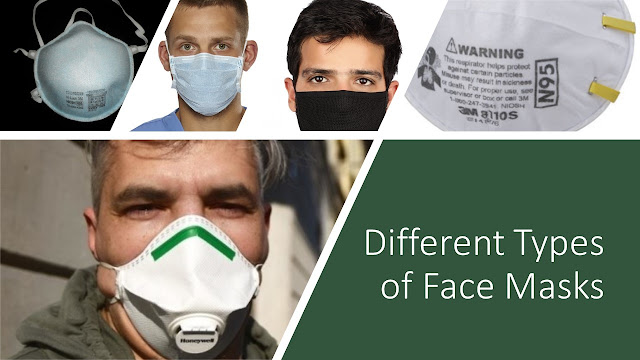With the sudden outbreak of pandemic COVID-19 (novel coronavirus), the requirement of a medical mask as Personal Protective Equipment (PPE) has out rocketed and this sudden situation has led to the unfair advantage of various mask manufactures for advertising or promoting various types of face masks in misguiding the common people. Thus, it is high time to know the options available. This article will focus on the types of masks available in the markets to help with better distinguishing between them.
When it comes to personal protective equipment (PPE) a face mask is one of the most indispensable equipments that we can trust for our safety. But it is most effective only when we have a complete awareness of all the options that are available in the market.
Currently, when it comes to masks, there are two types of equipment available:
Currently, when it comes to masks, there are two types of equipment available:
- Respirators
- Face masks
1. Respirators:
Respirators are designed to offer protection from both airborne and body fluid contaminants. They are generally made directly from a cloth-like filter material. The most popular materials include silicone, neoprene, and rubber for their rigidity, durability, comfort, and easiness to clean. There are different types of respirators available with different shapes and sizes. These are there to attain a perfect fit to the face and provide a tight seal. A proper seal between your face and the respirator forces inhaled air to be pulled through the respirator’s filter material and not through gaps between your face and the respirator.
Respirators are used routinely to protect against airborne infectious diseases such as tuberculosis, anthrax, SARS, and hantavirus because they protect against both large and small particles. Also, these are most advisable for the polluted and dusty environment as they can efficiently filter out the small dust particles suspended in the air.
| Respirators |
2. Face masks:
A facemask is a disposable mask that covers the nose and mouth. It is a tie-on mask of a non-woven hypoallergenic 3-ply construction with a filter in between. Examples of these are medical procedure mask, surgical mask, dental mask, isolation mask, and layer mask.
It works to keep out large droplets of contaminants from being spread by the person wearing them be that person is a patient or a health care worker considering its use in hospitals. The face mask also keeps splashes or sprays from reaching the mouth and nose of the person wearing the mask. It also prevents a person from flu from spreading the infection to others.
However, the face masks are not designed or certified to seal tightly against the face to prevent the inhalation of small airborne contaminants as during inhalation small airborne contaminants can pass through gaps between the face and the facemask or the material of the mask. They are not made to provide respiratory protection.
Here, the certification signifies that the masks have been tested for the ability to resist the contamination of both small and large particulates to pass through the mask.
| Medical Face mask |
N95 Respirator mask
With the above classification of the facepiece, there is an option available that can work both as a facemask as well as a respirator and that is a surgical N95 mask.
Filtering Facepiece respirators are divided into various classes based on their filtration capabilities. “N95 respirator” is a term used to describe the class of respirators which use N95 filters to remove particles from the air that is breathed through them. The NIOSH respirator approval regulation defines the term N95 to refer to a filter class that removes at least 95% of airborne particles during “worst-case” testing using a “most-penetrating” sized particle of 0.3 microns during NIOSH testing. Filters meeting the criteria are given a 95 rating. Many filtering facepiece respirators have an N95 class filter and those meeting this filtration performance is often referred to simply as N95 respirators. (*NIOSH stands for National Institute for Occupational Safety and Health and is the United States federal agency responsible for conducting research and making recommendations for the prevention of work-related injury and illness)
It is always recommended for a NIOSH approved N95 respirators for respiratory protection needs and this should be used as an identification for higher quality.
| N95 Mask Sample |
Non-pollution Mask
With the availability of the above category, a fabric mask is also available in the market currently made up of mesh and knitted fabric. These are now termed as non-pollution masks and function similar to that of a surgical mask but with an added advantage of washability. With this, it can be reused indefinitely after a proper wash until there is any physical damage.| Non-pollution mask |
Precautions to be followed for wearing the masks
Facemasks are not respirators and they do not provide respiratory protection. To get protection from both face masks and respirators, they need to be worn correctly and consistently while in use.- Ensure that there is no gap on either side of the mask and should be adjusted for a proper fit.
- Do not let the mask hang from the neck.
- For respirators, a tight fit in the face should be a must for its efficient use.
- While removing the mask it must be taken care not to touch the potentially infected outer surface of the mask.
- Disposable masks should not be reused for a prolonged period of time and are advised to change them if they look cluttered. For respirators, it is advisable to change them when they become soiled, damaged, or when breathing becomes difficult.
- Used masks should be considered as potentially infectious medical waste. In the hospital setting, it should be disposed of in the identified infectious waste disposal bag/container. In community settings where medical waste management protocol cannot be practiced, it may be disposed of either by burning or deep burial.

